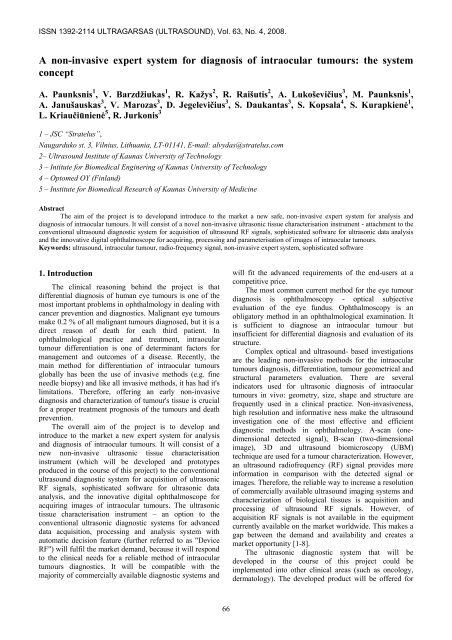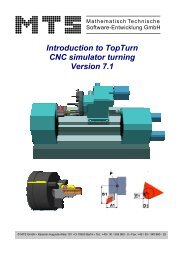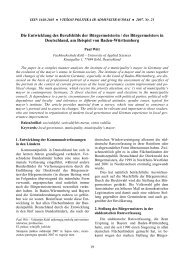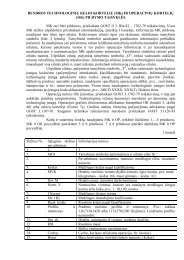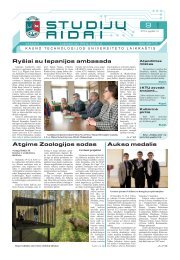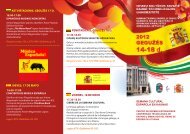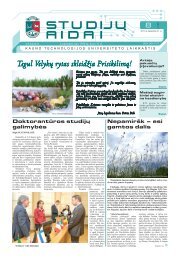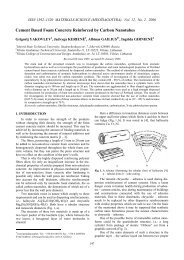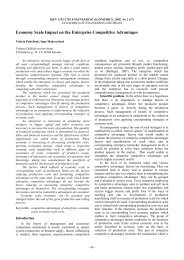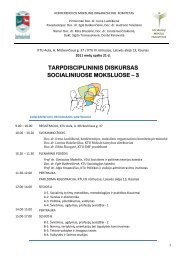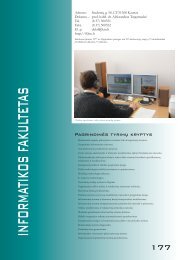A non-invasive expert system for diagnosis of - Kauno technologijos ...
A non-invasive expert system for diagnosis of - Kauno technologijos ...
A non-invasive expert system for diagnosis of - Kauno technologijos ...
You also want an ePaper? Increase the reach of your titles
YUMPU automatically turns print PDFs into web optimized ePapers that Google loves.
ISSN 1392-2114 ULTRAGARSAS (ULTRASOUND), Vol. 63, No. 4, 2008.<br />
A <strong>non</strong>-<strong>invasive</strong> <strong>expert</strong> <strong>system</strong> <strong>for</strong> <strong>diagnosis</strong> <strong>of</strong> intraocular tumours: the <strong>system</strong><br />
concept<br />
A. Paunksnis 1 , V. Barzdžiukas 1 , R. Kažys 2 , R. Raišutis 2 , A. Lukoševičius 3 , M. Paunksnis 1 ,<br />
A. Janušauskas 3 , V. Marozas 3 , D. Jegelevičius 3 , S. Daukantas 3 , S. Kopsala 4 , S. Kurapkienė 1 ,<br />
L. Kriaučiūnienė 5 , R. Jurkonis 3<br />
1 – JSC “Stratelus”,<br />
Naugarduko st. 3, Vilnius, Lithuania, LT-01141, E-mail: alvydas@stratelus.com<br />
2– Ultrasound Institute <strong>of</strong> Kaunas University <strong>of</strong> Technology<br />
3 – Intitute <strong>for</strong> Biomedical Enginering <strong>of</strong> Kaunas University <strong>of</strong> Technology<br />
4 – Optomed OY (Finland)<br />
5 – Institute <strong>for</strong> Biomedical Research <strong>of</strong> Kaunas University <strong>of</strong> Medicine<br />
Abstract<br />
The aim <strong>of</strong> the project is to developand introduce to the market a new safe, <strong>non</strong>-<strong>invasive</strong> <strong>expert</strong> <strong>system</strong> <strong>for</strong> analysis and<br />
<strong>diagnosis</strong> <strong>of</strong> intraocular tumours. It will consist <strong>of</strong> a novel <strong>non</strong>-<strong>invasive</strong> ultrasonic tissue characterisation instrument - attachment to the<br />
conventional ultrasound diagnostic <strong>system</strong> <strong>for</strong> acquisition <strong>of</strong> ultrasound RF signals, sophisticated s<strong>of</strong>tware <strong>for</strong> ultrasonic data analysis<br />
and the innovative digital ophthalmoscope <strong>for</strong> acquiring, processing and parameterisation <strong>of</strong> images <strong>of</strong> intraocular tumours.<br />
Keywords: ultrasound, intraocular tumour, radio-frequency signal, <strong>non</strong>-<strong>invasive</strong> <strong>expert</strong> <strong>system</strong>, sophisticated s<strong>of</strong>tware<br />
1. Introduction<br />
The clinical reasoning behind the project is that<br />
differential <strong>diagnosis</strong> <strong>of</strong> human eye tumours is one <strong>of</strong> the<br />
most important problems in ophthalmology in dealing with<br />
cancer prevention and diagnostics. Malignant eye tumours<br />
make 0.2 % <strong>of</strong> all malignant tumours diagnosed, but it is a<br />
direct reason <strong>of</strong> death <strong>for</strong> each third patient. In<br />
ophthalmological practice and treatment, intraocular<br />
tumour differentiation is one <strong>of</strong> determinant factors <strong>for</strong><br />
management and outcomes <strong>of</strong> a disease. Recently, the<br />
main method <strong>for</strong> differentiation <strong>of</strong> intraocular tumours<br />
globally has been the use <strong>of</strong> <strong>invasive</strong> methods (e.g. fine<br />
needle biopsy) and like all <strong>invasive</strong> methods, it has had it's<br />
limitations. There<strong>for</strong>e, <strong>of</strong>fering an early <strong>non</strong>-<strong>invasive</strong><br />
<strong>diagnosis</strong> and characterization <strong>of</strong> tumour's tissue is crucial<br />
<strong>for</strong> a proper treatment prognosis <strong>of</strong> the tumours and death<br />
prevention.<br />
The overall aim <strong>of</strong> the project is to develop and<br />
introduce to the market a new <strong>expert</strong> <strong>system</strong> <strong>for</strong> analysis<br />
and <strong>diagnosis</strong> <strong>of</strong> intraocular tumours. It will consist <strong>of</strong> a<br />
new <strong>non</strong>-<strong>invasive</strong> ultrasonic tissue characterisation<br />
instrument (which will be developed and prototypes<br />
produced in the course <strong>of</strong> this project) to the conventional<br />
ultrasound diagnostic <strong>system</strong> <strong>for</strong> acquisition <strong>of</strong> ultrasonic<br />
RF signals, sophisticated s<strong>of</strong>tware <strong>for</strong> ultrasonic data<br />
analysis, and the innovative digital ophthalmoscope <strong>for</strong><br />
acquiring images <strong>of</strong> intraocular tumours. The ultrasonic<br />
tissue characterisation instrument – an option to the<br />
conventional ultrasonic diagnostic <strong>system</strong>s <strong>for</strong> advanced<br />
data acquisition, processing and analysis <strong>system</strong> with<br />
automatic decision feature (further referred to as "Device<br />
RF") will fulfil the market demand, because it will respond<br />
to the clinical needs <strong>for</strong> a reliable method <strong>of</strong> intraocular<br />
tumours diagnostics. It will be compatible with the<br />
majority <strong>of</strong> commercially available diagnostic <strong>system</strong>s and<br />
66<br />
will fit the advanced requirements <strong>of</strong> the end-users at a<br />
competitive price.<br />
The most common current method <strong>for</strong> the eye tumour<br />
<strong>diagnosis</strong> is ophthalmoscopy - optical subjective<br />
evaluation <strong>of</strong> the eye fundus. Ophthalmoscopy is an<br />
obligatory method in an ophthalmological examination. It<br />
is sufficient to diagnose an intraocular tumour but<br />
insufficient <strong>for</strong> differential <strong>diagnosis</strong> and evaluation <strong>of</strong> its<br />
structure.<br />
Complex optical and ultrasound- based investigations<br />
are the leading <strong>non</strong>-<strong>invasive</strong> methods <strong>for</strong> the intraocular<br />
tumours <strong>diagnosis</strong>, differentiation, tumour geometrical and<br />
structural parameters evaluation. There are several<br />
indicators used <strong>for</strong> ultrasonic <strong>diagnosis</strong> <strong>of</strong> intraocular<br />
tumours in vivo: geometry, size, shape and structure are<br />
frequently used in a clinical practice. Non-<strong>invasive</strong>ness,<br />
high resolution and in<strong>for</strong>mative ness make the ultrasound<br />
investigation one <strong>of</strong> the most effective and efficient<br />
diagnostic methods in ophthalmology. A-scan (onedimensional<br />
detected signal), B-scan (two-dimensional<br />
image), 3D and ultrasound biomicroscopy (UBM)<br />
technique are used <strong>for</strong> a tumour characterization. However,<br />
an ultrasound radi<strong>of</strong>requency (RF) signal provides more<br />
in<strong>for</strong>mation in comparison with the detected signal or<br />
images. There<strong>for</strong>e, the reliable way to increase a resolution<br />
<strong>of</strong> commercially available ultrasound imaging <strong>system</strong>s and<br />
characterization <strong>of</strong> biological tissues is acquisition and<br />
processing <strong>of</strong> ultrasound RF signals. However, <strong>of</strong><br />
acquisition RF signals is not available in the equipment<br />
currently available on the market worldwide. This makes a<br />
gap between the demand and availability and creates a<br />
market opportunity [1-8].<br />
The ultrasonic diagnostic <strong>system</strong> that will be<br />
developed in the course <strong>of</strong> this project could be<br />
implemented into other clinical areas (such as oncology,<br />
dermatology). The developed product will be <strong>of</strong>fered <strong>for</strong>
end-users (doctors) and beneficiaries (patients/the society)<br />
and is going to be a high value-adding <strong>system</strong> enabling<br />
faster and better-in<strong>for</strong>med diagnostic decisions <strong>of</strong><br />
potentially terminal diseases at a reasonable cost. As the<br />
result, quality <strong>of</strong> a diagnostics and treatment will be<br />
improved essentially and the probability <strong>of</strong> the patient<br />
mortality related to malignant eye tumours will be reduced.<br />
The project “A Non-Invasive Expert System <strong>for</strong><br />
Diagnosis <strong>of</strong> Intraocular Tumours” will be implemented by a<br />
consortium that will include clinical, technological and<br />
market <strong>expert</strong>ise and will consist <strong>of</strong> Stratelus, a<br />
telemedicine development and services company,<br />
Optomed OY (Finland), Biomedical Engineering Institute<br />
<strong>of</strong> the Kaunas University <strong>of</strong> Technology, Ultrasound<br />
Institute <strong>of</strong> the Kaunas University <strong>of</strong> Technology and<br />
Department <strong>of</strong> Electrical and In<strong>for</strong>mation Technology <strong>of</strong><br />
Lund University (Sweden).<br />
The scope <strong>of</strong> the project is to create a qualitative new,<br />
safe, <strong>non</strong>-<strong>invasive</strong> <strong>system</strong>, consisting <strong>of</strong> a specialized<br />
technical equipment - the Device RF – the option to a<br />
conventional ultrasound scanner <strong>for</strong> acquisition and<br />
collection <strong>of</strong> RF signals from intraocular tumours and a<br />
sophisticated s<strong>of</strong>tware <strong>for</strong> data processing and<br />
parameterization. The created product will be compatible<br />
with most ultrasonic diagnostic equipment (scanners) on<br />
the market and will give a new in<strong>for</strong>mation about tumour<br />
tissue parameters and will satisfy the specific<br />
clinical/technological demands <strong>of</strong> end users.<br />
The fact that an ultrasound RF signal carries more<br />
in<strong>for</strong>mation <strong>for</strong> the clinical decision making, <strong>for</strong><br />
intraocular tumours in particular, is not a new knowledge<br />
and technologies <strong>for</strong> processing the ultrasound RF signal<br />
have existed, but this technology hasn't been developed to<br />
the hi-end level and applied in a commercially available<br />
medical equipment <strong>of</strong>fered to end-users.<br />
2. The role <strong>of</strong> ultrasound in ophthalmology<br />
Ophthalmological <strong>non</strong>-<strong>invasive</strong> devices (ultrasound<br />
scanners) are the most effective part <strong>of</strong> the<br />
ophthalmological diagnostic equipment which is gradually<br />
improved and have been applied in the world already <strong>for</strong><br />
30-40 years and about 30 years in Lithuania. However<br />
contemporary and technological achievements exceed the<br />
possibilities <strong>of</strong> an ophthalmological diagnostic equipment<br />
<strong>of</strong>fered in the market. As a result, the ophthalmological<br />
diagnostic equipment recently proposed in the market uses<br />
conventional methods, like detected imaging <strong>of</strong> the A-scan<br />
echographic signal (biometry), B-scan, 3D scan, UBM.<br />
Such imaging does not give possibility <strong>for</strong> user to apply<br />
more sophisticated data processing (time-frequency<br />
filtering, application <strong>of</strong> the modern model-based<br />
processing algorithms and etc.) Hence, innovations in this<br />
area are implemented with notably delays. This makes a<br />
gap in the market and provides possibility to create an<br />
innovative ultrasound <strong>system</strong> <strong>for</strong> original collection <strong>of</strong><br />
ultrasound RF signals, processing and differentiation <strong>of</strong><br />
intraocular tumours [1-8].<br />
The main alternative to the developments envisaged in<br />
the project is to analyse the conventional B-scan images<br />
using special image processing methods and algorithms<br />
including texture analysis, calculation statistical and<br />
ISSN 1392-2114 ULTRAGARSAS (ULTRASOUND), Vol. 63, No. 4, 2008.<br />
67<br />
morphological parameters <strong>of</strong> the image regions under<br />
interest.<br />
However in order to get as much as possible valuable<br />
in<strong>for</strong>mation about eye tumours and their structure there is<br />
needed to create methods and tools <strong>for</strong> extraction <strong>of</strong> a<br />
qualitative new and valuable in<strong>for</strong>mation from ultrasound<br />
radi<strong>of</strong>requency signals (RF). The RF ultrasound signal is a<br />
<strong>non</strong>-detected A-scan signal, which provides a much more<br />
in<strong>for</strong>mation about a tissue structure than conventional<br />
images, like a detected A-scan signal or B-scan image. The<br />
extraction and processing <strong>of</strong> RF signals in the time and the<br />
frequency domains is a possibility to improve the accuracy<br />
<strong>of</strong> medical imaging <strong>system</strong>s present in the market <strong>for</strong><br />
<strong>diagnosis</strong> and characterization <strong>of</strong> eye tumours. This also<br />
gives possibility <strong>for</strong> automatic classification <strong>of</strong> tumours.<br />
Tools and complementary in<strong>for</strong>mative methods <strong>of</strong> signal<br />
acquiring and processing <strong>for</strong> evaluation <strong>of</strong> valuable<br />
quantitative parameters must be created <strong>for</strong> getting a<br />
valuable in<strong>for</strong>mation about the eye tumours. A rapid<br />
progress in the area <strong>of</strong> digital signal acquiring and<br />
processing enables to solve this technological task. Hereby<br />
there comes a possibility to improve the ophthalmological<br />
ultrasound <strong>non</strong>-<strong>invasive</strong> equipment and by integration with<br />
the optical imaging to increase reliability <strong>of</strong> differential<br />
diagnostics [1-8].<br />
The product to be developed will have to meet the<br />
technical and clinical requirements set <strong>for</strong> it which will be<br />
based on what is needed <strong>for</strong> a clinical evaluation and<br />
decision making. The overall challenge is delivering a<br />
product that would be technologically advanced but easy to<br />
operate by medical/clinical people and able to withstand<br />
intensive usage at large hospitals with large numbers <strong>of</strong><br />
patients.<br />
The main problem and demand arises from the fact<br />
that available devices don’t ensure sufficient resolution <strong>of</strong><br />
tissue characterisation. CT, MRI, conventional ultrasonic<br />
scanners, optical devices are not able to classify tumour<br />
tissues by the fine internal microstructure.<br />
The technological challenge <strong>of</strong> this project is moving<br />
from conventional A/B-scan images to the raw RF<br />
ultrasound signal processing and allowing acquisition and<br />
processing <strong>of</strong> a RF signal at a significantly higher<br />
resolution (approximately more than 60 %) level. Such<br />
resolution will be achieved under the complex analysis in<br />
the time and the frequency domains.<br />
The quality <strong>of</strong> images used <strong>for</strong> the intraocular tumours<br />
diagnostics can be characterised by the following<br />
parameters: A-scan signal can provide up to 20 % clinical<br />
in<strong>for</strong>mation, B-scan image can provide up to 40% clinical<br />
in<strong>for</strong>mation, RF signals could provide with a maximum <strong>of</strong><br />
100 % clinical in<strong>for</strong>mation. For a clinical use in the<br />
intraocular tumours diagnostics, the RF signal should<br />
provide with at least 60 % more clinical in<strong>for</strong>mation<br />
(suitable to evaluate/per<strong>for</strong>m a priori <strong>diagnosis</strong>) as<br />
compared with ordinary A or B scans to be perceived as a<br />
more advanced solution by medical/clinical people [1-8].<br />
3. The hardware concept<br />
Requirements <strong>for</strong> the methodology <strong>for</strong> acquisition,<br />
processing and storing <strong>of</strong> A/B-scan images and RF<br />
signals/images are coming from recent 10 years study <strong>of</strong>
ISSN 1392-2114 ULTRAGARSAS (ULTRASOUND), Vol. 63, No. 4, 2008.<br />
clinical practise and demands, it gives motivation to<br />
develop such device [1-14].<br />
As the <strong>system</strong> created is going to be used primarily by<br />
medical/clinical people, the technical support and<br />
maintenance required should be minimal - there<strong>for</strong>e, the<br />
<strong>system</strong> (hardware and s<strong>of</strong>tware) must be designed the way<br />
it would be simple to operate (user-friendly), require a<br />
minimum maintenance and technical qualification <strong>of</strong><br />
operators, and have a low error probability in classification<br />
<strong>of</strong> eye tumours.<br />
According to the technical requirements (Table 1) <strong>of</strong><br />
the main ultrasonic <strong>system</strong>s which are used in<br />
ophthalmology [11-14], the block diagram <strong>of</strong> the<br />
<strong>system</strong>/attachment which is necessary to be developed was<br />
proposed by us.<br />
The block diagram <strong>of</strong> the advanced <strong>system</strong> which is<br />
being developed is presented in Fig.1.<br />
Ophthalmological<br />
ultrasonic transducer<br />
Matching electronic circuit in order to<br />
pick-up the signal which is reflected from<br />
human eye<br />
Programmable filters,<br />
central frequencies 7,<br />
10, 20 MHz, Δf=50%<br />
from fc at 3dB level<br />
Amplifier with<br />
variable K (TVG),<br />
K=10-60 dB,<br />
Δf=30 MHz (-3dB)<br />
Function <strong>of</strong> automatic gain<br />
control<br />
ADC 10 bits,<br />
200 MHz<br />
Raw digital samples<br />
68<br />
Table 1. Specification overview <strong>of</strong> B-scan diagnostic <strong>system</strong>s.<br />
Manufactures<br />
Accutome,<br />
Inc.<br />
Alcon<br />
Laboratories<br />
Model Advent AB Alcon®<br />
Ultra-<br />
Scan®<br />
Frequency 7.5 MHz,<br />
12.5 MHz,<br />
15.0 MHz <strong>for</strong><br />
B-scan.<br />
(11MHz<br />
broadband<br />
10 MHz<br />
and<br />
20 MHz<br />
Gain range 50-90 dB 40 to<br />
80 dB<br />
Depth 20/35/50/70 2,3,4,<br />
range mm<br />
5,6 cm<br />
Resolution n.s. 0.1 ± 0.05<br />
mm axial<br />
0.4 ± 0.10<br />
mm<br />
lateral, at<br />
20MHz<br />
Ophthalmological ultrasonic<br />
echoscope<br />
OTI Corp. Tomey<br />
Corp.<br />
OTI-Scan<br />
2000<br />
10 MHz<br />
supplied<br />
(optional<br />
20 MHz)<br />
UD-1000<br />
10 MHz<br />
& 20 MHz<br />
30-114 dB 1-60 dB<br />
43 or 50<br />
mm<br />
Axial<br />
direction<br />
0.15 mm,<br />
Lateral<br />
direction<br />
max. 0.2<br />
mm<br />
Analogue ultrasonic signal,<br />
frequency 7-25 MHz, pulse repetition frequency<br />
in frame 11 kHz, frame repetition frequency 9<br />
Hz<br />
„Movable“ buffer memory,<br />
range <strong>of</strong> memory window <strong>for</strong> a single<br />
signal is (from 25 up to 100 μs – in order<br />
to measure 36 mm distance inside the<br />
eye), duration <strong>of</strong> the whole scanning<br />
frame 48 ms<br />
Embedded controller<br />
<strong>for</strong> <strong>system</strong>s hardware<br />
control<br />
Advanced ultrasonic <strong>system</strong><br />
which is being developed<br />
Connector <strong>for</strong> additional monitoring <strong>of</strong> the amplified<br />
analogue signal<br />
USB 2 interface<br />
34.5 or<br />
46 mm<br />
lateral<br />
0,4mm<br />
axial<br />
0,3mm,;<br />
distance in<br />
curacy<br />
0,5mm<br />
Fig.1. Block diagram <strong>of</strong> the advanced ultrasonic signal capturing <strong>system</strong> concept: TVG – time varying gain; ADC – analog/digital converter
4. Review <strong>of</strong> cancer tissue characterization<br />
methods<br />
Intraocular images, shapes and geometrical parameters<br />
obtained from conventional <strong>system</strong>s are valuable in<br />
diagnostics and treatment monitoring. In cases <strong>of</strong><br />
complicated cancer diseases, planning and monitoring<br />
brachytherapy, eye physicians are facing with lake <strong>of</strong><br />
differential diagnostics parameters and methodologies<br />
implemented in clinical practice. During review <strong>of</strong><br />
ultrasound diagnostics research in intraocular cancer<br />
characterization methods we found many approaches.<br />
Many international research papers [8,15-20] show the<br />
attempts and possibilities <strong>of</strong> tumour tissues<br />
characterization using radio-frequency signal processing.<br />
We can list few specific examples <strong>of</strong> tumour tissue<br />
characterisation in eye. Primary malignant melanoma <strong>of</strong><br />
the choroid and ciliary body has been investigated by [21].<br />
They assumed that histological composition <strong>of</strong> tumour is to<br />
be detected with ultrasound backscatter analysis. Digital<br />
ultrasound data were processed to generate parameter<br />
images representing the size and concentration <strong>of</strong><br />
ultrasound scatterer, and authors conclude that radi<strong>of</strong>requency<br />
signal can be used <strong>non</strong>-<strong>invasive</strong>ly to classify<br />
tumours into high-risk and low-risk groups. Studies <strong>of</strong> [22]<br />
demonstrated a correlation between acoustic backscatter<br />
parameters and survival in ocular melanoma. Authors<br />
conclude that smaller scatterer size, lower acoustic<br />
concentration and greater spatial variability were found to<br />
correlate with high-risk microvascular patterns. In the<br />
research paper [23] was presented objective to standardize<br />
the tissue characterization. Measurements <strong>of</strong> frequency<br />
dependence <strong>of</strong> backscatter are more consistent (interlaboratory<br />
results) than measurements <strong>of</strong> absolute<br />
magnitude. Researchers [24] examined two mouse models<br />
<strong>of</strong> mammary cancer (a carcinoma and sarcoma) using<br />
quantitative ultrasound (QUS). Scatterer property<br />
estimates, i.e., the average scatterer diameter (ASD) and<br />
average acoustic concentration (AAC), were estimated<br />
from regions-<strong>of</strong>-interest (ROIs) inside the tumours.<br />
Authors [24] concluded the statistically significant<br />
differences observing <strong>for</strong> both the ASD and AAC<br />
estimates when using the new analysis bandwidth. The<br />
[25] report describes research results <strong>for</strong> spectral<br />
comparisons <strong>of</strong> four classes <strong>of</strong> human intraocular tumours<br />
and four classes <strong>of</strong> implanted tumours in the mouse. Three<br />
parameters <strong>of</strong> the power spectrum [25] have found to be<br />
collectively more significant <strong>for</strong> tumour characterization;<br />
specifically, these parameters are spectral slope (dB/MHz),<br />
intercept (dB), and statistical standard error. These<br />
parameters found significantly different among human<br />
spindle cell malignant melanomas, mixed/epithelioid<br />
malignant melanomas, metastatic carcinomas, and<br />
hemangiomas.<br />
Also Lithuanian researchers [5,26-30] have been<br />
investigating problem <strong>of</strong> intraocular tumours.<br />
Summarising reviewed literature we found that tissue<br />
and tumour characterisation obtained from spectral<br />
features <strong>of</strong> ultrasound radi<strong>of</strong>requency signal is perspective<br />
research direction. It is recommended to process signals in<br />
time-frequency domain, estimate central instantaneous<br />
frequency, instantaneous bandwidth, backscattering<br />
ISSN 1392-2114 ULTRAGARSAS (ULTRASOUND), Vol. 63, No. 4, 2008.<br />
69<br />
spectra, it is assumed that these parameters have physical<br />
origin in microstructure <strong>of</strong> tissues. The assumed frequency<br />
(scalar) and spectra (function) parameters relation to<br />
histological changes tissues microstructure (dimensions <strong>of</strong><br />
tens <strong>of</strong> micrometers) are undetectable with conventional<br />
(frequency <strong>of</strong> tens <strong>of</strong> megahertz) ultrasound B-scan<br />
diagnostic <strong>system</strong>s. But ultrasound waves <strong>of</strong> that frequency<br />
can penetrate whole eye tissue until orbit where tumours<br />
should be detected. There<strong>for</strong>e analysis <strong>of</strong> ultrasound<br />
signals <strong>of</strong> 10-20MHz frequency could enable estimation <strong>of</strong><br />
pathological changes <strong>of</strong> intraocular tissues.<br />
5. Algorithm structure <strong>for</strong> processing <strong>of</strong> primary<br />
signal<br />
In this section we attempt to present concept <strong>of</strong> radi<strong>of</strong>requency<br />
signal processing and user interface s<strong>of</strong>tware.<br />
The overview <strong>of</strong> signal processing algorithm we presented<br />
in the Fig.2.<br />
Normalization <strong>of</strong> RF primary signal<br />
Detection <strong>of</strong> echoscopy lines<br />
Formation <strong>of</strong> matrix <strong>of</strong> lines<br />
Advanced methods <strong>of</strong> RF signal processing<br />
RF signal logarithmic<br />
envelop evaluation<br />
Echo amplitude<br />
(conventional)<br />
Fussed image after Bscan<br />
conversion<br />
Raw Digital Samples<br />
Time-frequency<br />
trans<strong>for</strong>mation<br />
Ensemble empiric<br />
mode trans<strong>for</strong>mation<br />
Fusion <strong>of</strong> parametric images<br />
Acoustic backscatter<br />
spectral parameter<br />
Scatter effective size<br />
parameter<br />
User interface and decision support<br />
Scalar parameters in<br />
region <strong>of</strong> interest<br />
Decision support tools<br />
Hilbert Huang<br />
trans<strong>for</strong>mation<br />
Microstructure<br />
empirical parameter<br />
Fig. 2 Block diagram <strong>of</strong> the primary radio-frequency signal<br />
processing concept.
ISSN 1392-2114 ULTRAGARSAS (ULTRASOUND), Vol. 63, No. 4, 2008.<br />
The captured raw samples <strong>of</strong> a primary (radio<br />
frequency) signal have to be analyzed first to determine<br />
instances <strong>of</strong> the start <strong>of</strong> the echoscopy line or instants <strong>of</strong><br />
the ultrasound pulse excitation. The <strong>for</strong>med matrix <strong>of</strong><br />
echographic signals then could be processed at a single line<br />
or between lines as well. This matrix <strong>of</strong> echographic radi<strong>of</strong>requency<br />
data could be analysed using advanced methods<br />
which are described in the next section. After analysis the<br />
obtained parameters could be used to <strong>for</strong>m parametric<br />
images fusing and supplementing a conventional B-scan<br />
image available from the diagnostic <strong>system</strong>. The user will<br />
manipulate the fused parametric images and will be able to<br />
select the region <strong>of</strong> interest and obtain scalar parameters<br />
<strong>for</strong> a decision support.<br />
6. Advanced methods <strong>of</strong> RF signal processing<br />
At the development stage RF signals are planned to be<br />
analyzed using original programs implemented in the<br />
Matlab s<strong>of</strong>tware. Signal analysis is planned to be<br />
implemented in three domains: the time, the frequency and<br />
the joint time-frequency domain. The most perspective<br />
methods will be determined during modelling and<br />
evaluation stages. Based on literature review [31-36] and<br />
experience when analyzing other types <strong>of</strong> biomedical<br />
signals [37,38] the following methods were chosen <strong>for</strong> the<br />
further evaluation: ensemble empirical mode<br />
decomposition and discrete wavelet trans<strong>for</strong>m <strong>for</strong> the time<br />
domain analysis; the Fourier power spectrum and marginal<br />
Hilbert spectrum <strong>for</strong> the frequency domain analysis; the<br />
continuous wavelet trans<strong>for</strong>m (scalogram), short time<br />
Fourier trans<strong>for</strong>m (spectrogram) and the Hilbert – Huang<br />
trans<strong>for</strong>m (Hilbert nominal spectrum) <strong>for</strong> the joint timefrequency<br />
analysis. The ensemble empirical mode<br />
decomposition and the Hilbert – Huang trans<strong>for</strong>m methods<br />
were chosen since these are newest and are very well<br />
estimated by researches in methods [32, 33, 36, 37] <strong>for</strong><br />
high resolution signal analysis. Such methods are<br />
completely adaptive to the analyzed signal and provide the<br />
more detailed frequency and time resolution than<br />
traditional time–frequency representations with fewer<br />
artefacts. The Fourier methods (Fourier power spectrum<br />
and a short time Fourier) were chosen because these<br />
methods are traditional in clinical applications and very<br />
widely used in a commercial medical equipment. These<br />
methods also could be a good reference <strong>for</strong> the new<br />
developments. The Wavelet analysis based methods (the<br />
discrete wavelet trans<strong>for</strong>m and the continuous wavelet<br />
trans<strong>for</strong>m) were chosen because these methods have a<br />
good mathematical background, propose a good balance<br />
between the time and the frequency resolution, provides an<br />
opportunity to control features wanted to be extracted by<br />
choosing the mother wavelet and scales <strong>of</strong> interest.<br />
Another argument to use wavelet based methods is a big<br />
number <strong>of</strong> successful biomedical signal applications, that<br />
already exists and which is difficult to say about empirical<br />
mode decomposition and the Hilbert – Huang trans<strong>for</strong>m<br />
methods since they are very new and still are in a<br />
development stage, e.g. Hilbert – Huang trans<strong>for</strong>m was<br />
introduced in year 1998, the ensemble empirical mode<br />
decomposition first time was announced in year 2005.<br />
70<br />
It is assumed that contents <strong>of</strong> backscattered RF signals<br />
should reflect a tissue microstructure and signal processing<br />
analysis should reveal differences in the RF signals<br />
between healthy tissue and tumour or differences between<br />
different types <strong>of</strong> tumours. In order to achieve this a fine<br />
structure <strong>of</strong> the high resolution signal should be analyzed.<br />
It is planned to use the time domain methods <strong>for</strong> a signal<br />
segmentation and determination <strong>of</strong> regions <strong>of</strong> interest,<br />
while after the frequency and the time-frequency domain<br />
analysis these regions <strong>of</strong> interest should provide data<br />
reflecting the analyzed tissue properties. These data are<br />
necessary <strong>for</strong> characteristic parameters calculation <strong>for</strong> a<br />
decision support stage. Characteristic parameters should be<br />
selected from a large number <strong>of</strong> various quantitative<br />
parameters and characteristics as obtained from modelled<br />
and clinical signals by applying on them the above<br />
mentioned signal processing methods. The final set <strong>of</strong><br />
parameters and characteristics and their presentation <strong>for</strong>m<br />
should be chosen during a clinical trialing and testing after<br />
which a stand alone signal analysis s<strong>of</strong>tware should be<br />
developed.<br />
Conclusions<br />
As a result <strong>of</strong> this project, a scientific knowledge and<br />
competency <strong>of</strong> every partner will be elevated, the<br />
knowledge exchange process will be developed and<br />
possibilities <strong>for</strong> a new market development will appear.<br />
The developed innovative hardware <strong>system</strong> combined<br />
with a sophisticated s<strong>of</strong>tware using appropriate<br />
in<strong>for</strong>mation and communication technologies will provide<br />
more convenient intercommunication among physicians by<br />
per<strong>for</strong>ming consultations, in<strong>for</strong>mation and knowledge<br />
exchange <strong>for</strong> a fast differentiation <strong>of</strong> diagnosed tumour.<br />
Hereby the time between the right <strong>diagnosis</strong> <strong>of</strong> eye tumour<br />
and effective treatment will be minimized and the<br />
probability <strong>of</strong> patient’s death decreased.<br />
Acknowledgements<br />
This project “A Non-Invasive Expert System <strong>for</strong><br />
Diagnosis <strong>of</strong> Intraocular Tumours” 4297.NICDIT was<br />
supported by Agency <strong>for</strong> international science and<br />
technology development programmes in Lithuania.<br />
References<br />
1. Šebeliauskienė D, Paunksnis A. Echographic differentiation <strong>of</strong><br />
malignant intraocular tumors. Ultragarsas. 2001. Vol. 41. No.4. P.25-<br />
28.<br />
2. Collaborative ocular melanoma study group. Comparison <strong>of</strong> clinical,<br />
echographic, and histopathological measurements from eyes with<br />
medium sized choroidal melanoma in the collaborative ocular<br />
melanoma study: COMS report No.21, Arch. Ophthalmol. 2003.<br />
Vol.121. No.8. P.1163-1171.<br />
3. Jegelevičius D, Lukoševičius A, Paunksnis A, Barzdžiukas V.<br />
Application <strong>of</strong> data mining technique <strong>for</strong> <strong>diagnosis</strong> <strong>of</strong> posterior uveal<br />
melanoma, In<strong>for</strong>matica. 2002. Vol.13. No.4. P.455-464.<br />
4. Paunksnis A, Šebeliauskienė D, Mačiulis A, Kopustinskas A.<br />
Echografinio vidinių akies auglių ir tinklainės degeneracijų pokyčių<br />
klasifikavimo analizė, Elektronika ir elektrotechnika. 2002. Vol. 40.<br />
No.5. P.76-80.<br />
5. Žakauskas M., Mačiulis A., Kopustinskas A., Paunksnis A.,<br />
Krivaitienė D. Evaluation parameters and technique <strong>for</strong><br />
classification <strong>of</strong> intraocular tumours. Ultrasound. 2003. Vol. 49.<br />
No.4. P.48-52.
6. Verbeek A. M., Thijssen J. M., Osterveld B. J., Romijin R. L.<br />
Ultrasonic differentiation <strong>of</strong> intraocular melanomas: parameters and<br />
estimation methods. Ultrasonic imaging. 1991. P.27-55.<br />
7. Rask R., Jensen P. K. Precision <strong>of</strong> ultrasonic estimates <strong>of</strong> choroidal<br />
melanoma regression. Graefe’s Arch. Clin. Exp. Ophthalmo. 1995.<br />
P.777-782.<br />
8. Daftari I., Barash D., Lin S., O‘Brien J. Use <strong>of</strong> high-frequency<br />
ultrasound imaging to improve delineation <strong>of</strong> anterior uveal<br />
melanoma <strong>for</strong> proton irradiation. Phys. Med. Biol. 2001. Vol.45.<br />
P.579-590.<br />
9. Patent: SU1432802 (A1), 1988-10-23 , Inventor(s): Kažys R. [SU],<br />
Valdišauskas A. [SU], Mažeika L. [SU] Applicant(s): KPI [SU]<br />
Classification: - international: H04R17/00; H04R17/00; (IPC1-<br />
7): H04R17/00 - European: Application number: SU19864204049<br />
19861231 Priority number(s): SU19864204049 19861231<br />
10. Patent: SU1678327 (A1), 1991-09-23 Inventor(s): Paunksnis A.<br />
[SU], Vladišauskas A. [SU], Lukoševičius A. [SU], Daktaravičienė<br />
E. [SU]; Fridman F. [SU]; Skrebė A. [SU] Applicant(s): KMU [SU];<br />
KPI [SU] Classification: international:A61B8/00; A61B8/00; (IPC1-<br />
7): A61B8/00 European: Application number: SU19874209332<br />
19870312 Priority number(s): SU19874209332 19870312<br />
11. Silverman R.H. et. al. High-resolution ultrasonic imaging and<br />
characterization <strong>of</strong> the ciliary body. Investigative Ophthalmology &<br />
Visual science. 2001. Vol.42. No.5. P.885-893.<br />
12. Gohdo T. et. al. Ultrasound biomicroscopic study <strong>of</strong> ciliary body<br />
thickness in eyes with narrow angles. American journal <strong>of</strong><br />
ophthalmology. 2000. Vol.129. No.3. P.342-346.<br />
13. Song X. et. al. Research work <strong>of</strong> ultrasonic A/B scanner <strong>for</strong><br />
ophthalmology. Proceedings <strong>of</strong> the 20th Annual international<br />
conference <strong>of</strong> the IEEE engineering in medicine and biology society.<br />
1998. Vol.20. No.2. P.837-838.<br />
14. Silverman R. H., Ketterling J. A., Coleman A. N. High-frequency<br />
ultrasonic imaging <strong>of</strong> the anterior an annular array transducer,<br />
Ophthalmology. 2007. Vol.114. No.4. P.816-822.<br />
15. Liu Tian. Ultrasonic tissue characterization using 2-D spectrum<br />
analysis. Doctoral Dissertations. Columbia University. 2003. P.179.<br />
http://app.cul.columbia.edu:8080/ac/handle/10022/AC:P:5133<br />
16. Kawana K., Okamoto F., Nose H., Oshika T. Ultrasound<br />
biomicroscopic findings <strong>of</strong> ciliary body malignant melanoma. Jpn J<br />
Ophthalmol. 2004 Jul-Aug. Vol. 48(4). P.412-414.<br />
17. Torres V. L., Allemann N., Erwenne C. M. Ultrasound<br />
biomicroscopy features <strong>of</strong> iris and ciliary body melanomas be<strong>for</strong>e<br />
and after brachytherapy. Ophthalmic Surg Lasers Imaging. 2005<br />
Mar-Apr. Vol.36(2). P.129-138.<br />
18. Tunis A. S., Czarnota G. J., Giles A., Sherar M. D., Hunt J. W.<br />
and Kolios M. C. Monitoring structural changes in cells with highfrequency<br />
ultrasound signal statistics. Ultrasound in Medicine &<br />
Biology. August 2005. Volume 31. Issue 8. P. 1041-1049.<br />
19. Blanco P. L., Marshall J.C. A., Antecka E., Callejo S. A., Filho J.<br />
P. S., Saraiva V. and Burnier M. N. Characterization <strong>of</strong> ocular and<br />
metastatic uveal melanoma in an animal model. Investigative<br />
Ophthalmology & Visual Science. December 2005. Vol. 46. No. 12.<br />
P. 4376–4382.<br />
20. Mamou J. M. Ultrasonic characterization <strong>of</strong> three animal mammary<br />
tumors from three-dimensional acoustic tissue models. Ph.D. thesis.<br />
University <strong>of</strong> Illinois at Urbana-Champaign. 2005.<br />
21. Coleman D. J., Silverman R. H., Rondeau M. J., Boldt H. C.,<br />
Lloyd H. O., Lizzi F. L., Weingeist T. A., Chen X.,<br />
Vangveeravong S. and Folberg R. Non<strong>invasive</strong> in vivo detection <strong>of</strong><br />
prognostic indicators <strong>for</strong> high-risk uveal melanoma: Ultrasound<br />
parameter imaging. Ophthalmology. March 2004. Vol. 111. Issue 3.<br />
P. 558-564.<br />
22. Silverman R. H., Folberg R., Boldt H. C., Llod H. O., Rondeau<br />
M. J., Mehaffey M. G., Lizzi F. L., Coleman D. J. Correlation <strong>of</strong><br />
ultrasound parameter imaging with microcirculatory patterns in uveal<br />
melanomas. Ultrasound in medicine & biology. 1997. Vol. 23. No. 4.<br />
P. 573-581.<br />
ISSN 1392-2114 ULTRAGARSAS (ULTRASOUND), Vol. 63, No. 4, 2008.<br />
71<br />
23. Wear K. A., Stiles T. A., Frank G. R., Madsen E. L., Cheng F.,<br />
Feleppa E. J., Hall C. S., Kim B. S., Lee P., O'Brien W. D, Oelze<br />
M. L. Jr., Raju B. I., Shung K. K., Wilson T. A and Yuan J. R.<br />
Interlaboratory comparison <strong>of</strong> ultrasonic backscatter coefficient<br />
measurements from 2 to 9 MHz. Journal <strong>of</strong> ultrasound in medicine.<br />
2005. No. 24. P. 1235-1250.<br />
24. Oelze M. L. and Zachary J. F. Examination <strong>of</strong> cancer in mouse<br />
models using high-frequency quantitative ultrasound, Ultrasound in<br />
medicine & biology. 2006. Vol. 32. No. 11.P. 1639-1648.<br />
25. Colemon D. J., Lizzi F. L., Silvermon W. H., Helson L., Torpey J.<br />
H. and Rondeau M. J. A model <strong>for</strong> acoustic chorocterizotion <strong>of</strong><br />
intraocular tumors. Invest Ophthalmol. Vis Sci 26:545-550. 1985.<br />
26. Mačiulis A., Kopustinskas A., Paunksnis A., Šebeliauskienė D.<br />
Echografinio vidinių akies auglių ir tinklainės degeneracinių pokyčių<br />
klasifikavimo parametrų analizė. Electronics and Electrical<br />
Engineering. 2002. No. 5(40). P. 76-80.<br />
27. Jegelevičius D., Lukoševičius A., Paunksnis A., Šebeliauskienė D.<br />
Parameterisation <strong>of</strong> ultrasonic echographic images <strong>for</strong> intraocular<br />
tumour differentiation. Ultrasound. 2002. No.1(42). P.50-56.<br />
28. Žakauskas M., Mačiulis A., Kopustinskas A., Paunksnis A.,<br />
Kurapkienė S., Jegelevičius D. Echospectral methods <strong>of</strong> tissue<br />
evaluation. Electronics and Electrical Engineering. Kaunas:<br />
Technologija. 2004. No. 7(56). P. 70–73.<br />
29. Paunksnis A., Kurapkienė S., Mačiulis A., Lukoševičius A.,<br />
Špečkauskas M. The use <strong>of</strong> echospectral methods <strong>of</strong> tissue<br />
evaluation <strong>for</strong> follow-up <strong>of</strong> brachytherapy treatment. Ultrasound.<br />
2007. No.4(62). P.45-48.<br />
30. Jurkonis R., Daukantas S. Ultragarsinio radijo dažninio signalo iš<br />
fantomo dvimačio echoskopavimo apdorojimas imituojančių<br />
medžiagų charakterizavimui. Biomedicininė inžinerija (Biomedical<br />
engineering). Tarptautinės konferencijos pranešimų medžiaga. 2008<br />
m. spalio 23-24 d. Kaunas, <strong>Kauno</strong> <strong>technologijos</strong> universitetas. ISBN<br />
978-9955-25-576-5. Kaunas: Technologija. 2008. P. 183-190.<br />
31. Huang N., Shen Z., Long S., Wu M., Shih H., Zheng Q., Yen N.,<br />
Tung C. and Liu H. The empirical mode decomposition and Hilbert<br />
spectrum <strong>for</strong> <strong>non</strong>linear and <strong>non</strong>-stationary time series analysis. Proc.<br />
R. Soc. London. 1998. Vol. 454. P.903–995.<br />
32. Kerschen G., Vakakis A. F., Lee Y. S., McFarland D. M. and<br />
Bergman L. A. Toward a fundamental understanding <strong>of</strong> the Hilbert-<br />
Huang trans<strong>for</strong>m in <strong>non</strong>linear structural dynamics. Journal <strong>of</strong><br />
Vibration and Control. Jan 2008. Vol. 14. P. 77 - 105.<br />
33. Roulier R., Humeau A., Flatley T. P., Abraham P. Comparison<br />
between Hilbert–Huang trans<strong>for</strong>m and scalogram methods on <strong>non</strong>stationary<br />
biomedical signals: application to laser Doppler flowmetry<br />
recordings. Physics in medicine & biology. 2005. Vol. 50. No. 21.<br />
P. 5189-5202.<br />
34. Kizhner S., Blank K., Flatley T., Huang N.E., Petrick D.,<br />
Hestness P. On certain theoretical developments underlying the<br />
Hilbert-Huang trans<strong>for</strong>m. Goddard Space Flight Center. Publication<br />
Year: 2006. Added to NTRS: 2006-08-02. Document ID:<br />
20060002648.<br />
35. Wu Z., Huang N. E. Ensemble empirical mode decomposition: a<br />
ise-assisted data analysis method. Advances in Adaptive Data<br />
Analysis. 2009. Vol. 1. No. 1. P. 1-41.<br />
36. Hilbert-Huang trans<strong>for</strong>m and its applications. Editors N.E. Huang,<br />
S.S.P. Shen. World Scientific Publishing Co. Pte. Ltd. ISBN 981-<br />
256-376-8, Interdisciplinary mathematical sciences. 2005. Vol. 5.<br />
P.324.<br />
37. Janušauskas A., Marozas V., Lukoševičius A., Sornmo L. The<br />
Hilbert-Huang trans<strong>for</strong>m <strong>for</strong> detection <strong>of</strong> otoacoustic emissions and<br />
time-frequency mapping. In<strong>for</strong>matica. 2006. Vol. 17(1). P. 25-38.<br />
38. Janušauskas A., Jurkonis R., Lukoševičius A., Kurapkienė S.,<br />
Paunksnis A. The empirical mode decomposition and the discrete<br />
wavelet tran<strong>for</strong>m <strong>for</strong> detection <strong>of</strong> human cataract in ultrasound<br />
signals. In<strong>for</strong>matica. 2005. Vol. 16(4). P. 541-556.
ISSN 1392-2114 ULTRAGARSAS (ULTRASOUND), Vol. 63, No. 4, 2008.<br />
M A. Paunksnis, V. Barzdžiukas, R. Kažys, R. Raišutis, A. Lukoševičius,<br />
. Paunksnis, A.Janušauskas, V.Marozas, D.Jegelevičius, S.Daukantas, S.<br />
Kopsala, S. Kurapkienė, L. Kriaučiūnienė, R.Jurkonis<br />
Neinvazinė ultragarsinė sistema automatinei akies vidaus auglių<br />
diagnozei: sistemos koncepcija<br />
Reziumė<br />
Projekto tikslas yra sukurti kokybišką, naują, saugią, neinvazinę<br />
sistemą, susidedančią iš specializuotos techninės įrangos – radijo dažnių<br />
(RD) įrenginio, skirto RD gauti ir surinkti iš akies vidinių auglių, ir<br />
modernios programinės įrangos duomenims apdoroti ir parametrizuoti.<br />
Oftalmologijoje populiariausias akies auglio diagnozės metodas yra<br />
subjektyvus optinis akies dugno įvertinimas. Kompleksiniai optiniai ir<br />
ultragarsiniai tyrimai yra labiausiai paplitę neinvaziniai metodai akies<br />
72<br />
vidaus auglių diagnostikoje, taip pat atliekant diferencijavimą, auglio<br />
geometrinių ir struktūrinių parametrų įvertinimą.<br />
Radijo dažnio (RD) (angl. RF) ultragarsinis signalas yra<br />
nedetektuotas A vaizdo signalas, kuris duoda kur kas daugiau<br />
in<strong>for</strong>macijos apie audinių struktūrą nei standartiniai vaizdai, tokie kaip<br />
detektuotas A vaizdo signalas arba B vaizdas. Nagrinėjamas projekto<br />
technologinis sprendimas – RD signalo paėmimas iš standartinių A ir B<br />
vaizdų, leidžiantis RD signalą apdoroti daug geresne skiriamąja geba<br />
(daugiau nei 60 %), kas ypač svarbu diferencijuojant auglius<br />
mikrostruktūriniame lygyje.<br />
Pateikta spaudai 2008 12 15


